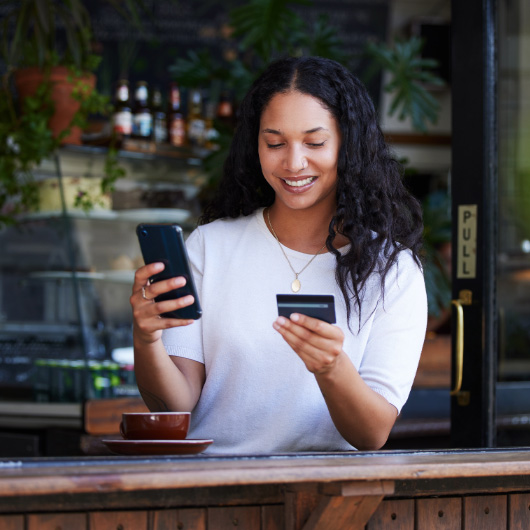15 Features Your Online Banking and Mobile App Should Have
15 Features Your Online Banking and Mobile App Should Have
We can accomplish a lot online and through our phones these days, and banking is no exception. Having access to your money and financial details from the convenience of your own home (or phone) has a big impact on the ability to spend, save and budget your money. More than that, you have peace of mind knowing you can access your account 24/7, wherever you are.Why online & mobile banking matter
Online and mobile banking allow you to easily bank wherever and whenever. It is banking on your schedule and when you need it most. Online banking and mobile banking are both feature-rich and offer benefits that can’t be found offline through traditional banking methods. You also have more control over your finances and instant access to essential financial tools on-the-go. Plus, if you’re wondering if mobile banking is free, both mobile and online banking are beneficial free tools for you to use as often as you’d like.
Curious about which features are most important for your banking experience? Keep reading below.
15 features your online banking & mobile app should have
1. Up-to-date account activity
The most fundamental feature your financial institution’s online banking or mobile app will offer is up-to-date account activity. Easily keep track of your finances by regularly reviewing this activity. Key items to take note of include:
- Transactions: These make up your account activity and include money coming into your account (i.e. direct and check deposits), and money going out of your account (i.e. debit card payments and ATM cash withdrawals).
- Each transaction will include a date, description and amount. Make sure you recognize each item to ensure there aren’t any unknown charges on your account.
- Pending/hold: You may also see transactions listed as pending on your account, which means they aren’t complete or fully posted to your account yet.
- Balance: In your account activity you should also be able to view a running count of your balance after each deposit or withdrawal, so you are aware of exactly how much money is in your account.
- Search: It’s also important for your account activity to include the ability to search so you can easily view transactions from a certain date range, to a certain biller, find a check image, etc.
2. Check account balance
Want to know how to check your current bank account balance online? Online and mobile banking give you quick access to your account balances anywhere, anytime. This gives you the advantage of knowing how much you have available before you make that next purchase. An extra perk is if your financial institution has a feature that allows you to view your balance without logging in to your account—saving you that extra step.
An important distinction to note on your account balance is your current and available balances. For example, if you’ve deposited a check for $200 but only $100 is available while the check finishes processing, your current balance will reflect the full $200 but your available balance will only account for the $100. This is important to take note of, especially if you have a low balance on your account, to ensure you aren’t spending more than the available balance in your account.
3. Account-to-account transfer
If you have multiple accounts at your financial institution (i.e. a checking and a savings account), it’s important to be able to easily transfer money as needed to build up savings or cover spending. Rather than visiting your bank in-person and filling out a slip, users who bank online or from their mobile banking app can instantly transfer funds between internal accounts with just a few taps on their screen. This is beneficial for those who actively use their different accounts on a regular basis, or are looking for more flexibility in their budgeting or savings.
4. Person-to-person transfer
With a person-to-person (P2P) transfer, you are able to send money quickly and easily to friends and family straight from your phone. Popular mobile payment apps include PayPal and Venmo. Zelle® is also a popular option and has the added convenience of being available directly in some financial institution’s online banking and mobile apps. Looking for online banking with Zelle®? Check to see if your bank offers it – enrolling is easy!
5. Bank-to-bank transfer
A bank-to-bank transfer allows you to transfer money between your different external accounts if you’re with more than one bank. This comes in handy if you have accounts for different purposes or are in the process of switching financial institutions, especially if you moved and aren’t near a physical location of one of the banks anymore. Make sure to take note of the amount of time for a bank-to-bank transfer, as these typically take more time than the instantaneous account-to-account transfer between your accounts at one place.
6. Mobile deposit
If you’ve ever sat on a check because you didn’t have time to make it to the bank before it closed, mobile deposit is the answer. This feature allows you to scan or take a photo of your check through your mobile app, and then deposit that balance into your account as if you’d deposited it in person.
7. Cleared check images
When you pay by check, copies of those checks are available online once the transaction completes. You can view these images by logging in to your online account, which could come in handy if you need copies or a reminder on what the payment was for.
8. Online bill pay
Online bill pay helps centralize your bills in one place, so you don’t have to chase down separate payment accounts every month. You should be able to:
- Immediately add and schedule billers to pay
- Create one-time, future-dated, and recurring bill payments to meet your needs
- Set reminders for upcoming bill due dates
9. Account alerts
When life gets busy, you set a reminder. It is crucial that your financial institution offer account alerts for events like low account balance, daily balance alert, transactions and more. Your financial institution should also provide the option to receive convenient account alerts by email or text message.
10. Card control services
To help avoid the stresses of a misplaced or stolen debit card, card control services give you the power to turn your card off until the card is found or replaced. Check to see if your financial institution additionally offers the ability to restrict transactions and set card-specific alerts, putting you fully in control of your card no matter where you are.
11. Fraud alerts
You should be able to feel confident that your money is safe at your financial institution, and a security feature that can help ease your mind is fraud alerts. These alerts notify you of potential suspicious activity on your account as it’s happening, so you always know what’s going on with your account.
12. Touch and Face ID
To help keep your mobile banking experience more secure, many banks offer Touch and Face ID authentication using fingerprint or facial recognition. These safeguards not only provide added protection, but also make it easier for you to sign into your account quickly without having to re-enter your password each time.
13. ATM & bank locator
Make sure your financial institution’s mobile app offers the ability to locate the nearest office location or in-network ATM, so you’re able to avoid fees whenever possible when out and about around town, or traveling.
14. View account statements online
Go green with eco-friendly, paperless account statements you can view online. Getting your statements online is faster and more secure than standard mail, and you don’t have to worry about the clutter of receiving paper statements each month. Having access to your bank statements online also makes it easier to make copies for things like taking out loans, proof of residency, rental applications, etc.
15. Self-service options
Take note of whether your financial institution includes features in their online banking experience that takes convenience to another level. Tasks that used to require a phone call or bank visit can be done online or from your phone, such as: reordering checks, stopping payments, ordering a personalized debit card and updating contact details (phone number, email, etc.).
Want to learn more about online and mobile banking? We’re here to help. Check out what else the online banking experience has to offer or contact your local Dollar Bank office today for additional assistance.
This article is for general information purposes only and is not intended to provide legal, tax, accounting or financial advice. Any reliance on the information herein is solely and exclusively at your own risk and you are urged to do your own independent research. To the extent information herein references an outside resource or Internet site, Dollar Bank is not responsible for information, products or services obtained from outside sources and Dollar Bank will not be liable for any damages that may result from your access to outside resources. As always, please consult your own counsel, accountant, or other advisor regarding your specific situation.
Posted: August 19, 2021




